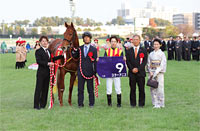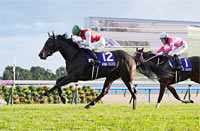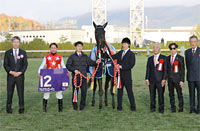Hanshin Juvenile Fillies (G1) - Data Analysis
Two-year-old fillies champion decider contested on the same stage as the Oka Sho
Liberty Island, the winner of last year’s Hanshin Juvenile Fillies, became the Triple Tiara champion in 2023, and 2020 winner Sodashi went on to achieve two victories in G1 races, including the Oka Sho (Japanese 1000 Guineas). Other two-year-old fillies that have won the Hanshin Juvenile Fillies have similarly enjoyed later success, so this suggests the race can be used as an indicator of future performance of young fillies. Let’s now look for some trends in this race based on the data for the last 10 years.
Focus on runners that have finished in the Top 3 in their previous race
The last 10 winners had all won or finished 2nd in their previous race. Few runners that had been beaten to 3rd or lower managed to pull off a comeback, with only four finishing in the Top 3. Meanwhile, runners that had finished 3rd in their previous race achieved a Top 3 ratio of 25.0%. We should therefore lower our expectations of runners that have finished 4th or lower in their previous race. [Table 1]
[Table 1] Performance by finish in previous race (last 10 years)
| Finish in previous race |
Performance
[1st-2nd-3rd-4th or lower] |
Win ratio |
Top 2 ratio |
Top 3 ratio |
| 1st |
8-7-4-73 |
8.7% |
16.3% |
20.7% |
| 2nd |
2-1-4-21 |
7.1% |
10.7% |
25.0% |
| 3rd |
0-1-1-6 |
0% |
12.5% |
25.0% |
| 4th or lower |
0-1-1-48 |
0% |
2.0% |
4.0% |
Also focus on the time difference in the previous race
Among runners that had finished in the Top 3 in their previous race, we can further narrow down our selection based on the time difference from the winner (or runner-up). Among runners that won their previous race, those that had won with a time difference of 0.2s or more from the runner-up achieved high success ratios. Among runners that had finished 2nd or 3rd in their previous race, those with a time difference of 0.1s or less from the winner would be the ideal choice. [Table 2]
[Table 2] Among runners that had finished in the Top 3 in their previous race, performance by time difference with winner (or runner-up) in that race (last 10 years)
| Finish, time difference in previous race |
Performance
[1st-2nd-3rd-4th or lower] |
Win
ratio |
Top 2
ratio |
Top 3
ratio |
| 1st in previous race, 0.2s or more |
4-5-1-26 |
11.1% |
25.0% |
27.8% |
| 1st in previous race, 0.1s or less |
4-2-3-47 |
7.1% |
10.7% |
16.1% |
| 2nd or 3rd in previous race, 0.1s or less |
2-1-4-12 |
10.5% |
15.8% |
36.8% |
| 2nd or 3rd in previous race, 0.2 or more |
0-1-1-15 |
0% |
5.9% |
11.8% |
Focus on runners with 2 or 3 career starts
Among runners over the last 10 years, a total of 51 runners had contested 4 or more races since their debut, but only one in this group finished in the Top 3. Similarly, among the 13 runners that came straight from a newcomer victory, only one finished in the Top 3. This means that we should basically focus on runners with 2 or 3 career starts when planning bets. [Table 3]
[Table 3] Performance by career starts (last 10 years)
| Career starts |
Performance
[1st-2nd-3rd-4th or lower] |
Win ratio |
Top 2 ratio |
Top 3 ratio |
| 1 |
0-1-0-12 |
0% |
7.7% |
7.7% |
| 2 |
5-4-4-35 |
10.4% |
18.8% |
27.1% |
| 3 |
5-4-6-51 |
7.6% |
13.6% |
22.7% |
| 4 or more |
0-1-0-50 |
0% |
2.0% |
2.0% |
Expect little from runners with 3 wins
Over the last 10 years, runners with 3 previous wins in JRA races have achieved the highest success ratios. However, since this group only produced two Top 3 finishers, it is hard to recommend runners with such a record. We should also note that highly favored runners have often failed to live up to expectations, such as Meikei Yell in 2020 (3rd favorite, 4th place), Jeune Ecole in 2016 (4th favorite, 11th place), and Horai Akiko in 2013 (2nd favorite, 7th place). In other words, it is risky to raise expectations based only on the number of wins. Finally, the only runner with 1 previous win in a JRA race to triumph in the Hanshin Juvenile Fillies was Liberty Island last year. We should therefore also slightly lower our expectations of runners with 1 previous win. [Table 4]
[Table 4] Performance by number of wins in JRA races (last 10 years)
| Number of wins in JRA races |
Performance
[1st-2nd-3rd-4th or lower] |
Win ratio |
Top 2 ratio |
Top 3 ratio |
| 3 |
1-0-1-5 |
14.3% |
14.3% |
28.6% |
| 2 |
8-7-5-75 |
8.4% |
15.8% |
21.1% |
| 1 |
1-3-4-68 |
1.3% |
5.3% |
10.5% |
Seek out the winner!
Runners that had finished in the Top 2 of the Artemis Stakes or won the Fantasy Stakes have the edge
In seven of the last eight years, the victory went to a runner that had either finished in the Top 2 of the Artemis Stakes or won the KBS Kyoto Sho Fantasy Stakes. The only exception to this trend was Lys Gracieux, who finished as runner-up in 2016 after having dominated the Artemis Stakes. This suggests we should select potential winners from the top contenders in the two major prep races. [Table 5]
[Table 5] Winners’ previous race and finish in that race (last eight years)
| Year |
Winner |
Previous race |
Finish in previous race |
| 2015 |
Major Emblem |
Artemis Stakes |
2nd |
| 2016 |
Soul Stirring |
Ivy Stakes |
1st |
| 2017 |
Lucky Lilac |
Artemis Stakes |
1st |
| 2018 |
Danon Fantasy |
KBS Kyoto Sho Fantasy Stakes |
1st |
| 2019 |
Resistencia |
KBS Kyoto Sho Fantasy Stakes |
1st |
| 2020 |
Sodashi |
Artemis Stakes |
1st |
| 2021 |
Circle of Life |
Artemis Stakes |
1st |
| 2022 |
Liberty Island |
Artemis Stakes |
2nd |
(Yodohito Himezono)
|


















